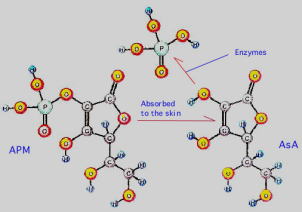
| @TOP b้ฦTvbOEMbAP5bAXRr__(๚{๊/p๊)bVCIPbvr^~bbgsbNbดฟคiXg|จโน |
 @@@@@
@@@@@| Jump to: | @(1)Structure and Appearance of APMb(2)Stability|(3)Whiteningb(4)Collagen Synthesisb(5)Absoption @(6)Antioxidation and Radical Trappingb(7)UV radiationb(8)Referencesb(9)E-Mail |
| iQjStability |
iStabilityj Aqueous solution containing 3% APM retains 95% unchanged APM after 6 months of storage at 40. As is clear from this test result, APM is highly stable.@ Aqueous solution containing 1% vitamin C develops a color and an offensive odor with complete loss of vitamin C after about 1 week of storage at 60. Aqueous solution containing 1% APM, by contrast, retains about 90% unchanged APM when stored under the same conditions as with vitamin C. กLink to Figer of stability of 3% APM solution กLink to Figer of stability of 1% APM solution APM is hydrolyzed to vitamin C by an enzyme called phosphatase which is present in the body. Its phosphate ester portion is detached by the action of the enzyme. |
 |
| (3)Whitening |